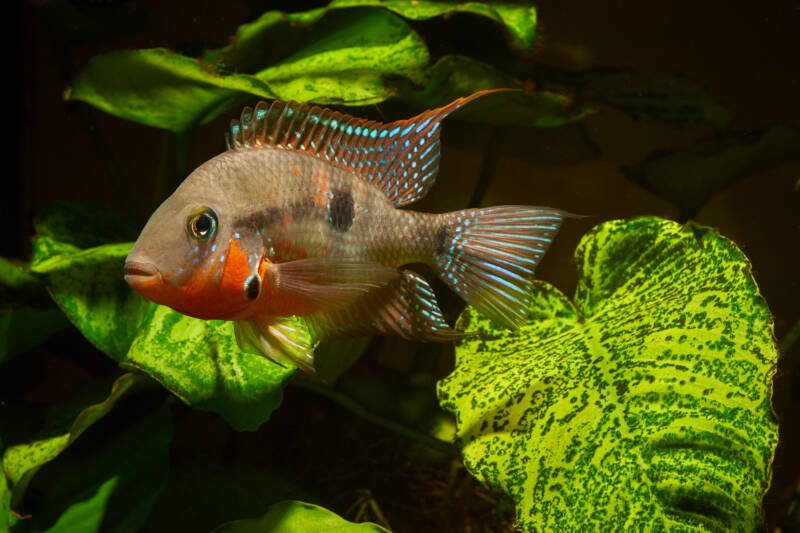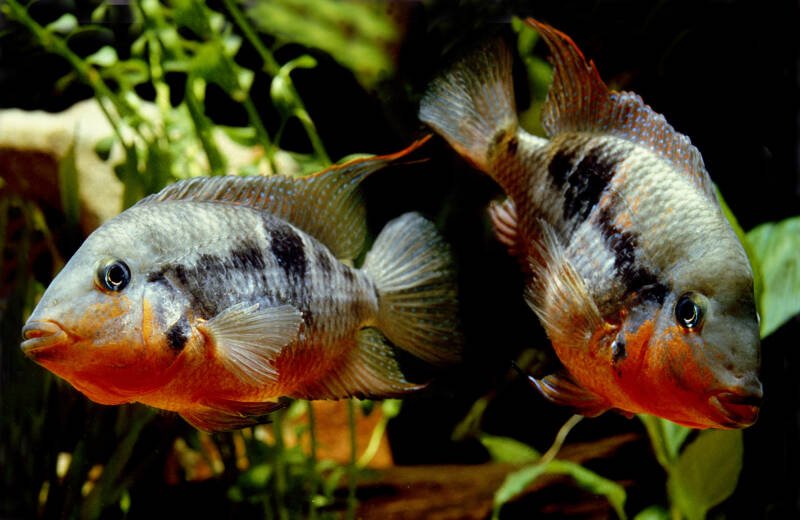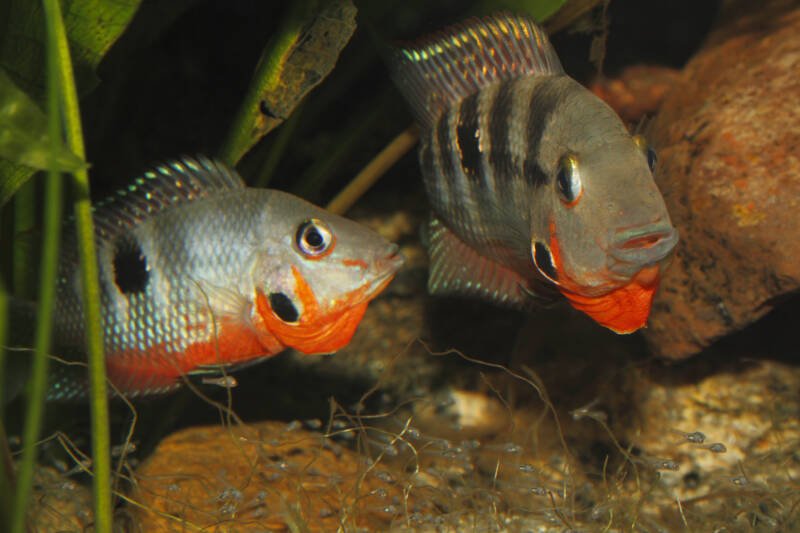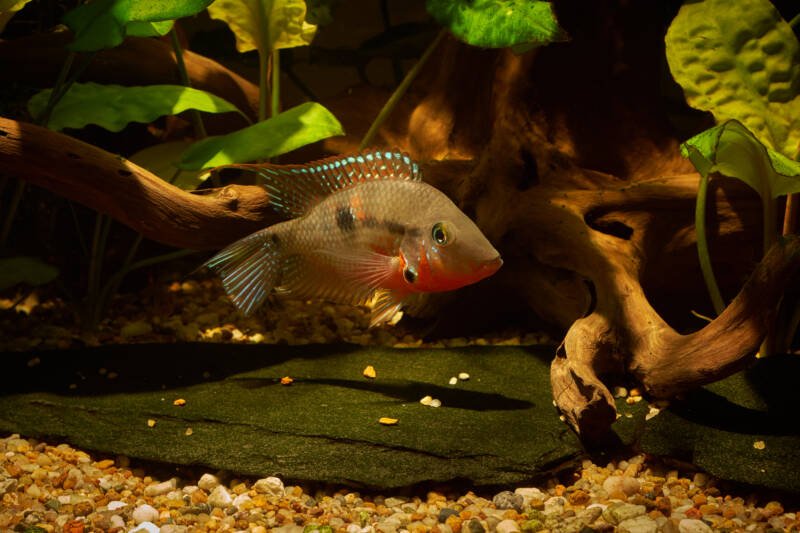Have you ever considered keeping cichlids in your aquarium, but felt intimidated by their reputation as a challenging fish for beginners?
Fear not! With proper attention and care, these colorful fish can be just as rewarding to keep as any other species.

One particularly captivating type of cichlid is the firemouth. With its vibrant hues and lively demeanor, this fish is sure to bring joy to any aquarium enthusiast.
Whether you’re a seasoned pro or just starting out, watching firemouth cichlids during spawning season is an experience like no other.
So why not take the plunge and add some firemouth cichlids to your aquarium?
At a Glance
| Minimum tank size: | 20 gal (80 l) |
| Temperature: | 70-75°F (21-24°C) |
| Lifespan: | up to 15 years, 8-10 years more common |
| Diet: | omnivore |
| Size: | 7 inches (17 cm) |
| pH: | 6.0-7.5 pH |
| Hardness: | 4-10 dKH |
| Ammonia: | < 2 ppm |
| Nitirite and nitrate: | 0 ppm |
In this article
Appearance, Sexing, Size, & Lifespan
Firemouth cichlids feature striking colors all across their bodies. With vivid red along their bottom of their bodies and a pearlescent turquoise covering the rest, these fish are certainly showstoppers.
From the bottom of their mouth to their upper stomach, they are a bright red that verges on orange for some fish.
Vertically along their bodies is a series of black and grey bands that start behind their eyes and continue all the way to the caudal fin.
All of their fins have spots in a remarkable turquoise. There is red edging along their dorsal fins, while the pelvic and anal fins are edged in black.
It’s easier to sex these fish since females are less brightly colored and have a blunt genital papilla.

Additionally, males have more sharply pointed dorsal and anal fins, though this can be a less distinctive trait.
Neither the largest nor the smallest cichlids, these fish can grow up to 7” (17 cm).
Firemouth cichlids can live up to 15 years. However, 8 – 10 years is a more common lifespan. Either way, this is a serious commitment to make.
Behavior: Docile or Aggressive?

Like many (or rather, most) cichlids, the firemouth cichlid can be semi-aggressive and tends to become territorial.
This behavior is exacerbated during the spawning season.
To minimize aggressive behaviors, meet these basic needs and preferences below:
- Make sure you have a very fine, sandy substrate for burrowing.
- There should also be plenty of free swimming space.
- Avoid overstocking or even moderately to heavily stocking your tank.
- Try to keep bottom-dwellers and other low-level fish to a minimum.
- Don’t add other aggressive or territorial fish to the community.
Though some of these tips may seem obvious, it’s always better to be more cautious.
A cichlid of this size can easily cause harm to itself or others if housed in an inappropriate tank or with unsuitable tank mates.
But under the right circumstances, the firemouth cichlid can actually be a peaceful community fish.
Natural Habitat
Firemouth cichlid (Thorichthys meeki) is a freshwater breed in the Cichlidae family that is native to Central America and South America. These cichlids inhabit slow-moving rivers that are warm nearly year-round.

Though they may live near other firemouth cichlids, they are not schooling fish. Instead, they will carve out specific territories.
This fish is very hardy, both in the wild and in the commercial trade. Though beneficial for hobbyists, this has proven to be problematic elsewhere.
In North America, firemouth cichlids have been considered an invasive species due to the damaging ecological impacts they have on native fish and fauna populations.
Resource competition and predation are the two most common and worst effects. Combined with a fast growth rate, trophic opportunism, and easy adaptation, their hardiness has become both a boon and a curse.
Preparing Your Tank for Firemouth Cichlids
This new world cichlid needs at least 30 gallons. If you want to keep it in a community aquarium, you should double this.
Long or tall tanks will work with firemouth cichlids, but they do better by far in long tanks.
Larger tanks will allow them to carve out specific territories, which will, in turn, reduce stress and lead to more peaceful behavior.
Required Equipment
Besides increasing the gallon size, you’ll also need to invest in the equipment below.
- Filtration: Almost any type of filter will work for this type of fish. However, it should be powerful enough to handle larger tanks and multiple inhabitants.
- Heating: In order to keep these freshwater fish warm enough, you’ll need to invest in a quality heater. A thermometer is also recommended so that you know if the water is verging on too hot or cold.
- Lighting: The type of lighting for firemouth cichlid aquariums will largely depend on whether or not you have live plants. If you do, make sure the lights can support them. If you don’t, almost any type of light will work.
- CO2 Setup: Similar to lighting, you’ll only need a CO2 setup if you have live plants that are more high maintenance. If you don’t have live plants, you won’t need to inject carbon dioxide into the aquarium.

Each piece of equipment has options that can fit every budget. There are more cost-effective brands on the market as well as more expansive products.
But no matter how much you spend, how the equipment performs in the most important aspect to consider. Carefully read reviews and, if possible, watch product demos.
Recommended Tank Elements
Once you have the right equipment and are sure the gallon size is correct, it’s all about how to set up the environment. What do you need to make the firemouth cichlid feel at home? It’s actually pretty simple.
- Plants: Both live plants and silk fake plants will work fine with these fish. But if you do choose to stock live plants, make sure they’re hardier varieties. They should be able to handle rougher treatment and have protected root surfaces.
- Rocks: Rocks, rocks, and more rocks are what these types of cichlids prefer! It doesn’t matter if you’re providing flat rocks, smooth stones, or more elaborate rockwork. As long as the cichlids can hide among the rocks, they’re happy.
- Driftwood: For those who can’t acquire or don’t like rocks, driftwood is an acceptable substitute. Create a network of roots and branches that these fish can spend time navigating throughout the day.
- Substrate: There’s only one type of acceptable substrate for firemouth cichlids: sand. You’ll need a sandy substrate for these fish to burrow in and eventually place their fry in after a successful spawning.

With these in place, the firemouth cichlid will be less aggressive and more focused on engaging in natural behaviors.
You’ll be able to watch them burrow in the sand, flit through tangles of driftwood, and even spawn.
Water Parameters and Ranges
Firemouth cichlids can handle a fairly broad range of water hardness but are more specific with regard to temperature and pH.
- pH Range: These cichlids prefer a pH range that is close to neutral but slightly acidic. It’s fine if the water falls between 6.0–7.5 pH. Even half a point above or below this range is fine, but don’t go beyond that.
- Temperature: Considering their native habitat, it’s no surprise these tropical fish prefer warmer waters. Keep the aquarium heated to 70-75°F in order to keep firemouth cichlids comfortable.
- Hardness: This is the broadest parameter range that these fish can handle, which makes this requirement easy to meet. As long as the water is within 4–10 KH, you won’t have to make any adjustments.
As long as you keep your aquarium within these ranges, your firemouth cichlid will thrive.
To provide the best quality of life, you should also perform routine tank maintenance and weekly water changes.
This will keep the ammonia, nitrite, and nitrates as close to 0 ppm as possible. Including live plants is another way to naturally reduce the level of nitrates, although it can’t replace water changes.
Tank Mates and Compatibility
In order to prevent aggression issues, it’s best to house firemouth cichlids with active fish of a similar size.
Slower fish will be subject to bullying. Larger or aggressive fish may be subject to outright threat displays, or may conversely attack the firemouth cichlid.
Compatible tank mates for community aquariums include:
- Other South American cichlids that aren’t overly aggressive;
- Schooling fish such as the tetra, rummy nose, and glowlight;
- Some bottom-dwelling catfish, such as the pictus catfish.
Firemouth cichlids can be housed with other of their species, but there should be ample room for each to have his own generous territory.
Males will live alone, though they may form monogamous pairs with any females in the tank.
If this is the desired result, it’s best to purchase a male-female pair at the same time, rather than introducing them at separate times.
Food and Diet
Firemouth cichlids are omnivores that will accept most foods, though they have a preference for meaty foods. Some common meals are:
- Bloodworms
- Tubifex
- Brine shrimp
- Ocean plankton
- Cichlid pellets
- Quality flakes.
These fish will accept frozen, live, and freeze-dried foods.
There is debate within the aquarium community whether feeding cichlids live foods causes more aggression.
Though there is no definitive evidence of this, several hobbyists have reported more problems with fin nipping and chasing on live diets.
If you decide to transition your cichlid to a live diet, monitor their behavior carefully.
Spawning and Parenting
Unlike many other fish, firemouth cichlids are excellent parents that will work together as a family.
Both the male and female will rear and care for their fry before and after hatching.
In order to view this spawning and parenting behavior, you’ll need to have sand and flat rocks in your aquarium.
You’ll also need both a female and male firemouth cichlid (duh, right?) and must maintain a non-hostile aquarium environment.
Female cichlids will clean the flat rocks and lay anywhere from 100 to 500 eggs on them.
After hatching, the fry will be placed in protective pits dug into the sand. The parents may dig several different pits and periodically move the fry until they mature.
Fry can be fed newly-hatched brine shrimp, infusoria, finely crushed flakes, and powdered pellets.
Though firemouth cichlids are extremely dedicated to their offspring, the fry become independent of their parents within weeks of hatching.
Because of this, these cichlids have time to raise several broods throughout the year.
This can quickly become an overstocking issue, so make sure any spawning that takes place is intentional on your part.
If the fish accidentally spawn, contact local fish stores to see if they can take the fry once matured or remove the eggs from the tank.
Owning Firemouth Cichlids
Though firemouth cichlids may not be perfect for every community freshwater aquarium, they are still very enjoyable fish to keep.
Their semi-aggressive temperament and special environmental needs can cause some tank owners to hesitate.
But for the aquarists that are willing to put in the work, these beautiful fish show stunning natural behaviors.
They are especially interesting to watch during the spawning season.
Owning a firemouth cichlid may be more difficult, but it is certainly a rewarding experience.